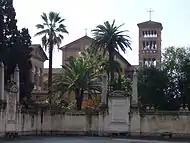Sant'Anselmo all'Aventino
Sant'Anselmo all'Aventino ("Saint Anselm on the Aventine") is a Roman Catholic church, monastery, and Pontifical University located on Cavalieri di Malta Square on the Aventine Hill in Rome's Ripa rione. It is named in honor of the Benedictine monk Saint Anselm of Canterbury. The complex is under the care and oversight of the Benedictine Confederation and it's Abbot Primate.
| Sant'Anselmo all'Aventino | |
|---|---|
Chiesa di Sant'Anselmo all'Aventino | |
 | |
 Sant'Anselmo all'Aventino | |
| Location | Piazza dei Cavalieri di Malta, Rome |
| Country | Italy |
| Denomination | Roman Catholic |
| Tradition | Latin Rite |
| Website | ateneo |
| History | |
| Status | Active |
| Dedication | Anselm of Canterbury |
| Dedicated | 1900 |
| Architecture | |
| Functional status | Active |
| Architect(s) | Hildebrand de Hemptinne |
| Architectural type | Church |
| Style | Romanesque Revival |
| Specifications | |
| Number of spires | 1 |
| Clergy | |
| Rector | Rev. Doroteo Toić OSB |
History
The buildings were designed by Belgian Benedictine Abbot Hildebrand de Hemptinne and Fidelis von Stotzingen. Sant'Anselmo is built in a neo-romanic style, atop of Roman ruins which date from the 1st century BC to the 4th century AD. These remains are visible and visitable, by arrangement, under both the first courtyard and in the basement. The church is mainly known to the local Roman people because of the performance of Gregorian chant for Ora Media (mid-day prayer at 12:50 pm each day) and Vespers (evening prayer at 7:15 pm each day). Lauds (morning prayer) and Mass are chanted in Italian.
The church was built by Francesco Vespignani between 1892 and 1896, on a land given by the Knights of Malta to the Benedictines. Vespignani built it according to the project of Abbot Hildebrand de Hemptinne. The church is made of three naves, divided by granite columns. The ceiling is a truss and the apse is covered by a mosaic. The crypt is made of 5 naves. The church has a basilica plan, and the apse mosaics depict the jeweled cross between angels and Saints Benedict and Anselm, the work of the German monk Radbodus Commandeur. The paschal candlestick is modern but in the Cosmatesque style. The lower level has now been converted to the use of the library for the University. Next to the entrance of the lower level library is a statue of St Benedict, with his arms raised in prayer - the posture in which he died.

In the courtyard of the atrium, there is a bronze statue of St Anselm, made in the late 20th century by Swiss sculptor A. Wider from Widnau. From here, it is possible to see Santa Maria del Priorato of the Knights of Malta, which lies in an adjacent complex that is closed to the public. In the entrance to the monastery, reached from the atrium, is a Roman mosaic of Orpheus mosaic that was found when the college was built.[1]
Sant’Anselmo is a triple institution: the place of academic studies (the Pontifical Atheneum of St. Anselm) – originally for the Benedictines, but also open to external students; the college (collegio), where the monks, religious and priests who study both at the University and at the other Roman pontifical universities live; and the Curia of the Benedictine Abbot Primate, the highest representative and coordinator of the Benedictine Confederation. The Pontifical Atheneum of St. Anselm includes faculties of Philosophy, Theology, Monastic Studies, and the Institute of Historical Theology, as well as the Pontifical Institute of Sacred Liturgy. The Pontifical Atheneum of St. Anselm grants certificates and diplomas in various subjects, as well as Bachelor, Licentiate, and Doctoral degrees.
Cardinal-Deacons
In 1985 Pope John Paul II made the church a "cardinalate diakonia" or titular deaconary.
- Paul Augustin Mayer, O.S.B. (25 May 1985 Appointed - 30 Apr 2010 Died)
- Fortunato Baldelli (20 Nov 2010 Appointed - 20 Sep 2012 Died)
- Lorenzo Baldisseri (22 February 2014 – present)